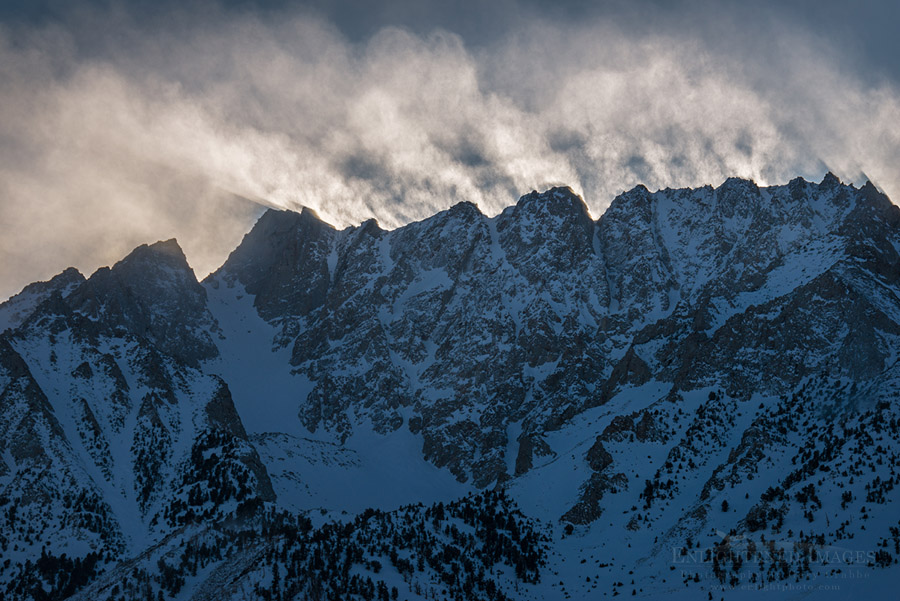
Five Great Photography Tips that Galen Rowell Taught Me:
Photo: (Above) Snow banners streaming off the summit of Basin Mountain, Inyo County, Eastern Sierra, California
It was fifteen years ago this month that internationally-renowned photographer Galen Rowell and his wife, Barbara, perished in a plane crash in their hometown of Bishop, California. They were on the very last leg of a long return voyage home after teaching a workshop in the Arctic. In a moment, we lost one of the best-known photographers who helped pioneer the genres of climbing and adventure travel photography and helped to elevate the genre of landscape photography with what he called the Dynamic Landscape.
I was one of those fortunate enough to work with him over the course of many years. I spent nearly a decade managing his image library of nearly 400,000 photos. My employment with him began not too long after I graduated from college; It was my first real job that didn’t involve cooking. I felt an incredible sense of gratitude and loyalty as Galen seemed to fill a tiny bit of the hole that was left after my dad passed away just the year before. But to be absolutely clear: I was hired to work for him precisely because I had ZERO interest in becoming a photographer. The fact I had one basic B&W photography course in college and was fairly well-versed in geography and the outdoors was good enough for them. They (Galen and Barbara) wanted someone who would be OK working in an office and not want to be out in the field making photos. I was fine with that since I never even shot a roll of color film until after I started working for him, and I was pretty much a really bad photographer, knowing only the very basics of basics beyond “Point and Click.”
However, one of the prime benefits of working for Galen was getting to work during all of his photo workshops. By the time my tenure was over, I must have assisted or helped teach at nearly 40 of his classes. For me, it was like learning photography through a combination of osmosis and intravenous fluid transfer simultaneously.
Twenty-seven years after I first entered the world of photography, first learning the ropes as a photo-editor and then stumbling into the role of professional photographer, author, and workshop instructor myself, and now fifteen years after Galen’s passing, I realize there are a few indelible lessons I learned from my time with him that I continue to pass along to students to this day. In honor of his memory, I’d like to share a few of those with you here.
(1) “If it looks good, shoot it; If it looks better, shoot it again.”
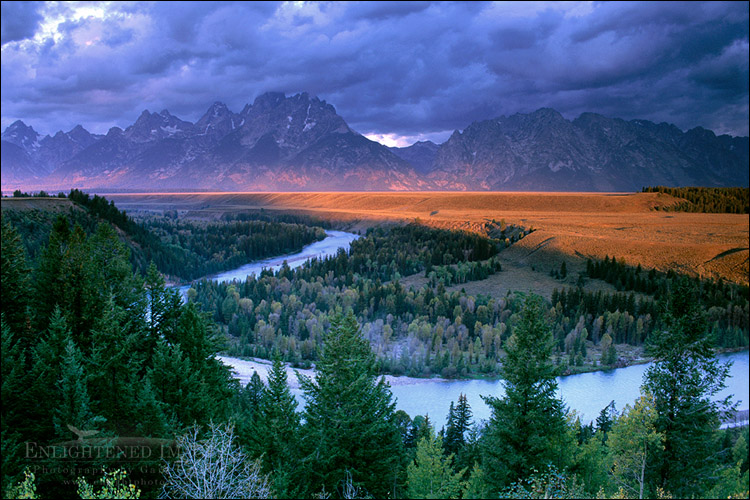
(Photo: Stormy sunrise over the Grand Tetons from the Snake River Overlook, Grand Teton National Park, Wyoming.)
Back in the day of using film, and now one of my favorite stories: I clearly remember the strange looks I got amidst a phalanx of photographers during a stormy sunrise from the Snake River Overlook in Grand Teton National Park when I shot a full roll of film in a few short moments. While I was busy changing rolls of film in my camera, I overheard a nearby photographer turn to his partner and ask, “Should we be shooting this,” to which his partner replied, “No, you want to wait until the light is all the way up on the mountain.” – So they didn’t shoot, and guess what, the light never made it onto the mountain. If it looks good, shoot it, because there’s always a chance the scene won’t get better, and if you didn’t shoot the first time, you have nothing to show. As Galen used to say in tandem with this, “Film is Cheap.” These days, I just add, “…and pixels are even cheaper.”
(2) “Chance Favors the Prepared Mind.”
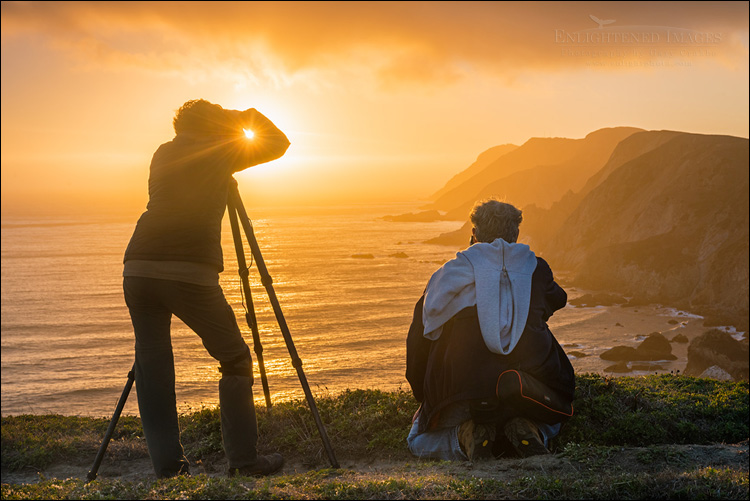
(Photo: Photographers shooting the sunset at Point Reyes National Seashore, Marin County, California.)
Galen often passed along this gem — attributed to the famous scientist Louis Pasteur — but with the photographic aspect being that one of the prime ways photographers could get better photos was to have a thorough understanding of their subject, the world around them, and to research as much as possible, thereby stacking the odds of getting a good shot to their favor. In terms of landscape and travel photography, that meant researching locations, understanding local and general weather patterns, understanding the direction or type of light relative to the subject you wanted to shoot, etc.. As workshop instructors who teach out in the field, this is what most do well in advance of their class which is to scout locations, look up sunset/sunrise times and try to deliver their students to these best spots at the best times. But the real teaching moments come not just in talking about camera settings or lens selection, but equally to the “why here – why now” factor of choosing a subject or location in the first place.
(3) The Importance of Previsualization.
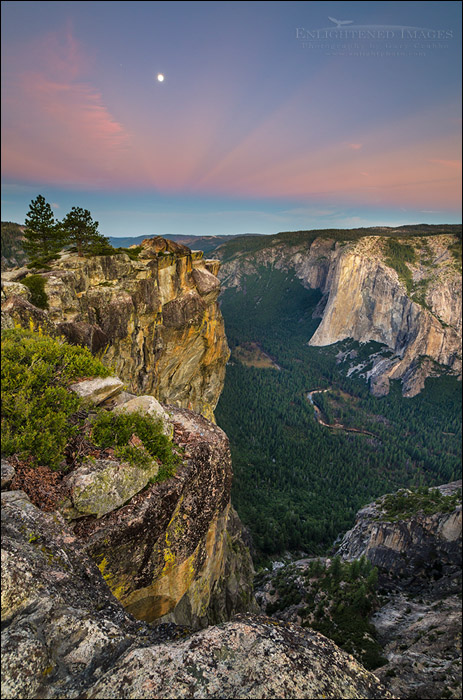
(Photo: Moonset at dawn over Yosemite Valley from Taft Point, Yosemite National Park, California)
Galen used to talk a lot about Previsualizing your image. In today’s digital photo world, there’s barely a camera out there that won’t let you chimp through or inspect your image as soon as you’ve shot it. This wasn’t the way the world worked back in the days of film when you’d have no clue how your shot would look until they were processed in the lab. Well, sorta… but not really; Galen used to emphasize that the hallmark of a good photographer was their ability to previsualize in two distinct ways. The first was to think about the type of shot they wanted, what kind of subject(s) they wanted to show, and how they wanted to construct an idealized yet ethereal frame in their head. This was the starting point that would then guide them through their research to find the best location and conditions that would turn that ethereal vision into an actual photo. The second aspect was done on location and occurs even before a camera is lifted to your eyes. This deals with knowing how their finished shot would look using a certain film, lens, lighting, etc., and to understanding how the subjects in front of you in a 3-dimensional world would turn out after being compressed into a 2-dimensional medium.
In one instance, I remember sitting outside the far eastern gate of Yosemite National Park during the evening thinking about where I wanted to be to catch the moonset the next morning. I pulled out my maps, and with the help of mobile apps like The Photographer’s Ephemeris or PhotoPills and various weather sites, I realized I stood a great chance of capturing the moon setting over Yosemite Valley from Taft Point. Of course, this meant driving 2.5 hours through the park in the middle of the night and hiking more than a mile downhill well before the first light of dawn. I had constructed an ideal frame in my head, thinking it would have a moon hanging in the western sky over Yosemite Valley, which would be lit with a pinkish-purple light of dawn. Once I arrived on the scene, I was able to assess where to put my tripod and what other technical considerations were needed to bring that vision into reality. These days you don’t need to think about knowing how a certain film palette would translate certain colors, but you should be able to previsualize how you might process a scene while looking through a viewfinder before you even press the shutter.
(4) “Move!”
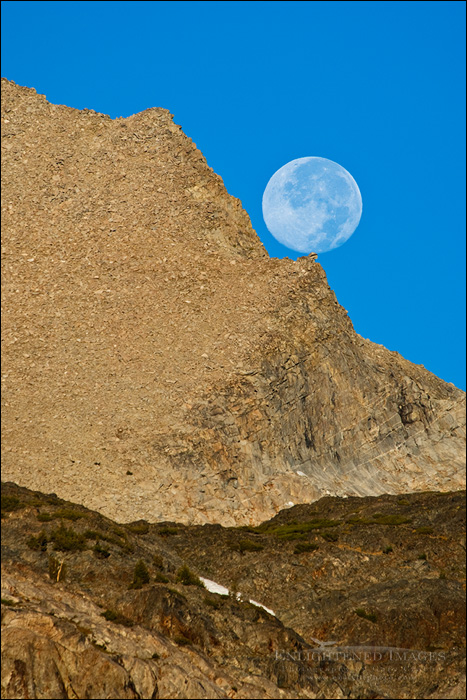
(Photo: Moonset over the Sierra Crest, near Tioga Pass, Mono County, Eastern Sierra, California.)
In one of his videos, Galen was running along the shore of Mono Lake chasing a sunset when he passed by the camera and breathlessly exclaimed, “Photography is an Action Sport!” Now that’s not to say we all need to climb mountains to get good photos, but during his workshops, he always emphasized the importance of moving and anticipating to improve your composition and visual story-telling. Every object in your frame has some visual relationship to every other object in your frame. How these objects are placed relative to each other can determine the success or failure of your image to communicate what you’re trying to show your audience. Often, the very first frame won’t be your best, and by moving your camera position, you improve your story. Sometimes that’s just tipping your camera up or down, right or left, but more often it means physically moving the camera position; taking a step (or two, three, or ten), bend down, climb up, move forward or backward. When dealing with objects or subjects that are moving, don’t just randomly take a photo. Figure out where the best spot in the frame is, and if you need to wait or move to put that object in that place, then that’s what you do.
In this shot of the moon setting over the Sierra, I was in one location when I first shot while the moon was higher in the sky. As the moon neared the horizon, I tried to visualize where it would touch the mountain. I saw this rock pinnacle and imagined the proverbial ball on the nose of a seal. I was anticipating the movement of the moon and needed to move my own position relative to the moon and the mountain so they would intersect at the right time and for just the briefest of moments.
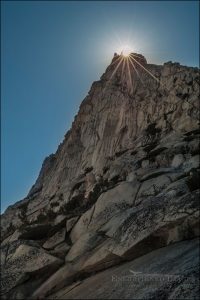 Galen also used to love teaching how if you were on a hill at the right time, you could move up or down the hillside so you could photograph more than one sunrise or sunset. For instance, If you’re on the side of a hill watching a sunrise, just after the sun comes up, you can run downhill back into the shadow and watch the sun rise a second time. If you have the stamina after watching the sunset, you could run uphill from the shadows back into the sunlight and photograph the sun setting a second, third, or fourth time – depending on how much hillside and stamina you had to work with.
Galen also used to love teaching how if you were on a hill at the right time, you could move up or down the hillside so you could photograph more than one sunrise or sunset. For instance, If you’re on the side of a hill watching a sunrise, just after the sun comes up, you can run downhill back into the shadow and watch the sun rise a second time. If you have the stamina after watching the sunset, you could run uphill from the shadows back into the sunlight and photograph the sun setting a second, third, or fourth time – depending on how much hillside and stamina you had to work with.
(5) “Fill the Frame with what you like.”
In combination with his discussion on movement and how that relates to the idea of composing subjects within the frame relative to each other, one point Galen always made was regarding strengthening your visual story, which would also lead to the development of personal vision or style. This is the ‘How You See The World’ – and how you use the photographic medium to communicate to others that which you find interesting, To that end, he would always push the premise of finding those aspects that you like, then fill the frame (or as much as possible) with those aspects to emphasize what you’re trying to show. The image of the Snow Banners on Basin Mountain (above) is a prime example of this. Standing down in the Buttermilk Region below the mountain, I saw these streamers of cloud and light coming off the mountain, but with a wide-angle ‘landscape’ lens they occupied only a tiny, distant portion of the image. Switching to a telephoto lens allowed me to fill the frame with this really interesting subject, such that the viewer is left with no doubt about what I am trying to show them.
I often tell folks I could look at a sheet of twenty 35mm slides and within 1-2 seconds know whether there was any image on that page that was worth taking a closer look at or send to a client. Because even then, at the size of a postage stamp, you could tell that certain images just jumped off the page due to the clarity with which the subject was being portrayed within that tiny little frame.
BONUS: (6) Figures in a Landscape
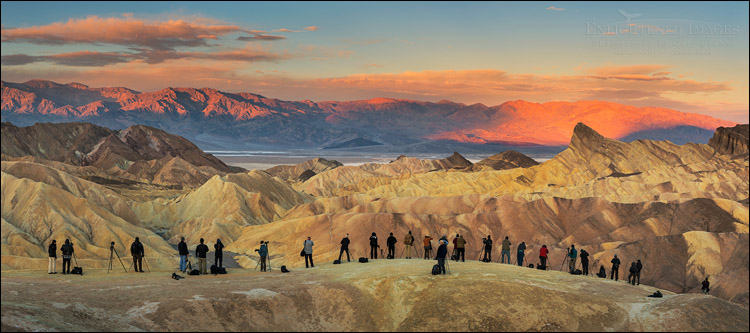
(Photographers lined up at dawn at Zabriskie Point, Death Valley National Park, California)
So many photographers who pursue landscape, nature, or travel often express disgust when some person(s) wander into their frame while they’re shooting. If you’d like to experience this for yourself, take a short stroll and stand under Utah’s Delicate Arch within the minutes just before sunset. You’ll hear a chorus of upset voices yelling at you to move. But Galen loved including people in his images, including landscapes. In fact, one chapter in his seminal book, Mountain Light, is called “Figures in a Landscape.” Including a person adds to the story of an image beyond what a straight landscape photo is capable of providing. It calls to our sense of human experience and our connection to the world around us.
But sometimes, we just don’t give a hoot about those lofty ideals, and there someone sits before us ruining our ideal shot. In these moments, I’ve been able to think back about that Figure in a Landscape aspect and use that to change my mindset. One time I was hanging out with some friends while they were leading a photo workshop in Death Valley. Their group arrived early, but apparently not early enough. Some other well-known photographer had gotten their large workshop group there first and had them all set up on a ridge below and directly in front of the tourist viewpoint. If you were a photographer who wasn’t able to walk down the hillside to join the line, you had no choice but to deal with this scene of many people in your view. Since I wasn’t too worried about trying to get another postcard shot from this location, I just sat with the other tourists and a few other photographers absorbing the scene. And to be totally honest, I felt a bit sad and disgusted at the ‘selfishness’ of the leader that put their class in this spot without regard to the rest of the folks around them. Then in a moment of thinking about all these figures within the landscape, I instantly decided to make this my shot, shooting a multi-frame panorama to capture the full line of people. This image wound up describing the feeling and experience of being there that morning far better than any other image I could have taken of just the landscape alone.
So here it is, fifteen years later. I still tip my hat and say a very heartfelt Thank You to Galen. He taught so many people how to see the world better, and he led by example of how to live a life of adventure and beauty at full throttle.
“If it looks good, shoot it; If it looks better, shoot it again.”
—
![]()
If you like this post , I would greatly appreciate it if you’d consider sharing this with your friends using one of the Social Media sharing buttons located at the top of this post. You can also sign up to receive free updates by email when future posts are made to this blog.
![]()
—
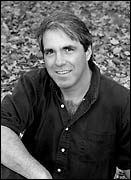 Gary Crabbe is an award-winning commercial and editorial outdoor travel photographer and author based out of the San Francisco Bay Area, California. He has seven published books on California to his credit, including “Photographing California; v1-North”, which won the prestigious 2013 IBPA Benjamin Franklin Gold Medal award as Best Regional title. His client and publication credits include the National Geographic Society, the New York Times, Forbes Magazine, TIME, The North Face, Subaru, L.L. Bean, Victoria’s Secret, Sunset Magazine, The Nature Conservancy, and many more. Gary is also a photography instructor and consultant, offering both public and private photo workshops. He also works occasionally a professional freelance Photo Editor.
Gary Crabbe is an award-winning commercial and editorial outdoor travel photographer and author based out of the San Francisco Bay Area, California. He has seven published books on California to his credit, including “Photographing California; v1-North”, which won the prestigious 2013 IBPA Benjamin Franklin Gold Medal award as Best Regional title. His client and publication credits include the National Geographic Society, the New York Times, Forbes Magazine, TIME, The North Face, Subaru, L.L. Bean, Victoria’s Secret, Sunset Magazine, The Nature Conservancy, and many more. Gary is also a photography instructor and consultant, offering both public and private photo workshops. He also works occasionally a professional freelance Photo Editor.
![]()
—


I took 2 workshops from him, the last the summer before he died. Your list encompasses the exact things I took away from those workshops. Now, I don’t always execute them but I still think of them today. Nice article and I think your list is spot on.
Being a climber I knew Galen in the mid-late-seventies, lost track of him, then through a friend happened upon a workshop of his at Rock Creek, then found Mountain Light… little pieces of serendipity. I still miss him.
Beautiful article. Galen must have been a very special person to know. Though I never got to meet him, I’ve certainly gotten to know a lot about him through you.
Gary….Wow. Has it already been 15 years? Nice remembrance. I knew Galen pretty well and still very much miss him. One spring I talked him into doing a special shoot with me in Yosemite for CNN. Everything went well and we were shooting early light on Yosemite Falls when Galen decided he could get a better shot by climbing out on a thin, leafless tree not far from where the fall was pooling. Well, he climbed the tree and it bent so far under his weight that the only shot he could get was water spray on his lens. But he gave it a great try. Another time, he and Alan Bard and I were skiing in the sierra and there was this relatively steep downhill run and Galen leaped off first and soon lost an edge and performed an awesome face plant. Bardini and I raced to see if he was OK and he plucked himself out of the snow and announced, “That was fun. Let’s do it again!” And he was amazing when I would drop by the gallery with my young children and they just adored him. You were lucky to work with him and I damn sure miss him all the time.
Gary thank you for the timely reminder and the thoughtful photo tips. Fifteen year! seems just like last month; I was riding home from work in Oakland on BART when I saw the headlines in someones newspaper (yes newspaper) that famed photographer dies in Bishop in a plane crash!
Galen was my hero at least my photography hero. I remember attending a Friday night slide show of his in 1974. Being in engineering school I always made sure I took Friday night off. The slide show showed the High Sierra, a place I discovered in 1971; the photos were spectacular. I was simply amazed. Time passes, work presses, and children occur, I mean are born and raised. Children grow up and I restarted taking photos. Imagine my surprise when in November 2000 in an Emeryville warehouse I attended a seminar on Fine Art Digital Printing. Galen was learning how to print digitally i.e. not in a darkroom with chemicals; Galen was very thorough and I learned a tremendous amount.
Just to round up the degrees of separation my wife’s friend went to high school with Galen. OK enough, but for one more, Galen settled in Bishop Ca where I worked on sewer installation project one of my first jobs. Memories.
Hard to believe it has been 15 years. I met Galen and Barbara through my involvement with the Yosemite Fund. In 1991 we had a donor event in Tuolumne and we all climbed up the back of Lembert Dome for a group picture (we were a pretty small group then) and Galen came straight up the face in record time to meet us at the top. Shortly before the plane crash I purchased and framed his photo “Fall Sunrise on the High Sierra, Over the Owens Valley’ and it hangs in my kitchen here in Novato where I can see it every day and feel like I am there in my beloved Eastern Sierra.
Thanks so much for your post.
UNSET THE SUNSET! Thanks for the memories… and the reminders!
Lovely tribute and act of love which is also the heart of what we do.
Hard to imagine a better tribute and remembrance of Galen. I first saw Galen’s work at a day-long workshop he conducted in southern New Jersey in late-1986 (circa). He had just published “Mountain Light” and the images and his lecture were something I had never before seen. What an inspiration and motivation! A lesson from Galen that is sometimes overlooked, and one that I aspire to practice, is “keep it simple” when you go into the field. Do not burden yourself with too much equipment – it will just slow you down. It’s been a while but his typical field kit was on display at the Mountain Light gallery in Bishop. Striking simplicity of gear; incomparable images.
Between the lines I feel your admiration for your mentor, Gary. He certainly continues to influence all of us who have studied his work and writings. I enjoyed reading this and always find comparing Galen’s ideas to my father’s creatively expanding. Of the main points you mention, I believe Dad and Galen would concur on a little over half of them, diverge slightly on a few and differ significantly on some too. These differences are what makes learning from various leaders so interesting and useful. It is also refreshing to read high quality teachings from someone with many years of experience. Thank you for sharing these energizing pointers.
I very much enjoyed this post about Galen Rowell and the comments. Although I wasn’t fortunate enough to meet him, I stopped several times at Mountain Light, his gallery in Bishop that sadly has closed. I also bought some of his books. Not only was he an excellent photographer, but he was great at expressing himself through written views of photography. It is very nice you can share his insights.
Attn.: Gary Crabbe…
Gary—I have a copy of the June 1974 issue of National Geographic (magazine). That’s the issue that featured Galen’s ascent of Half Dome, and I’d like to mail this to you. I’d been saving it to give directly to Galen—then came the crash, and it’s been on my shelf ever since. This issue is in good condition; no markings.
Galen and I became acquainted in 1990-’91 when he expressed interest in our new camera/lens support hardware. (I’m the guy that initially created Really Right Stuff, later selling our company to the current owners in mid-2002.) BTW, RRS is still extant; refer…https://kb.reallyrightstuff.com/knowledge/our-story
I’ll need your mailing address. Please advise.
Bryan Geyer
574 Dana St, Unit A
San Luis Obispo, CA 93401-3434
e-mail: geyer.bryan@gmail.com